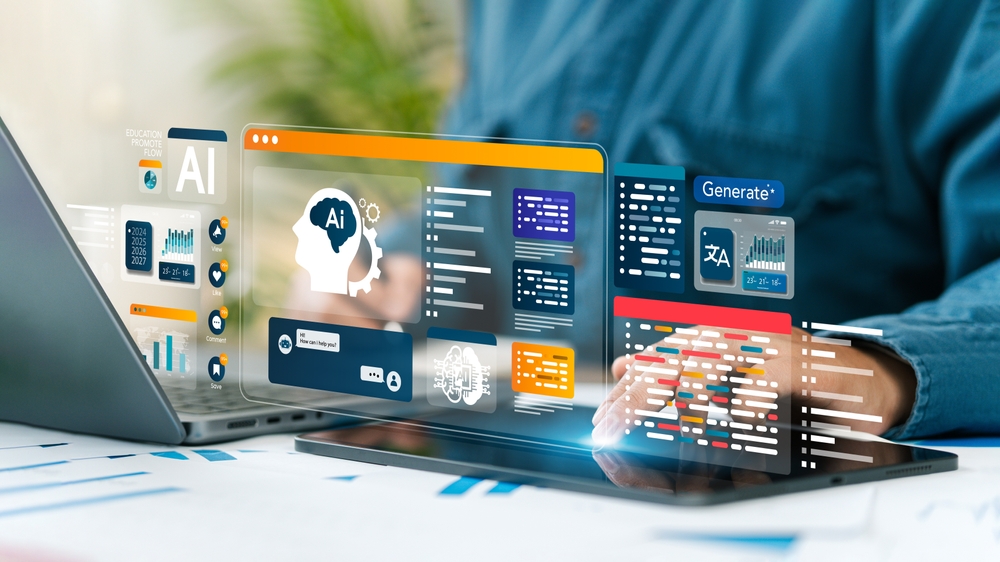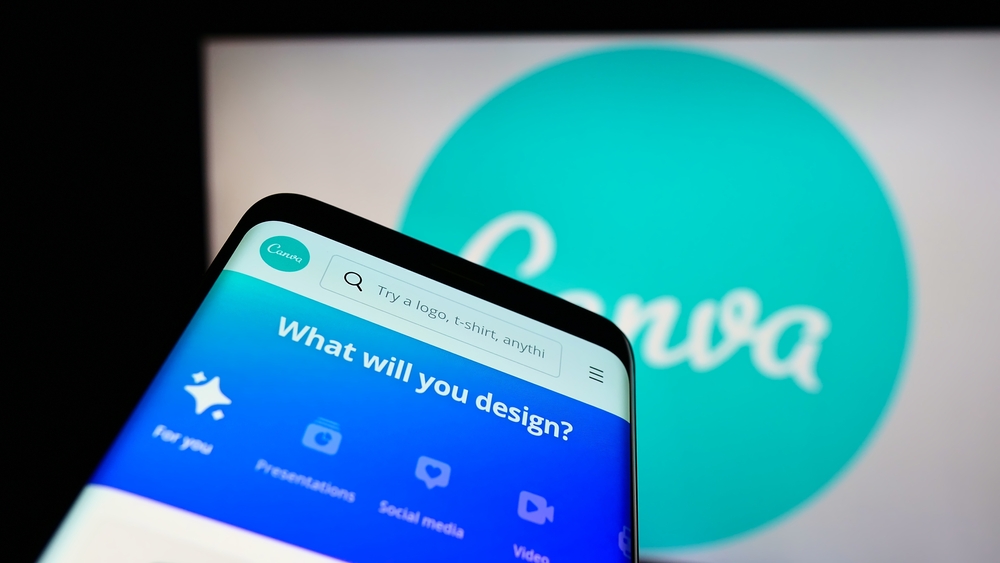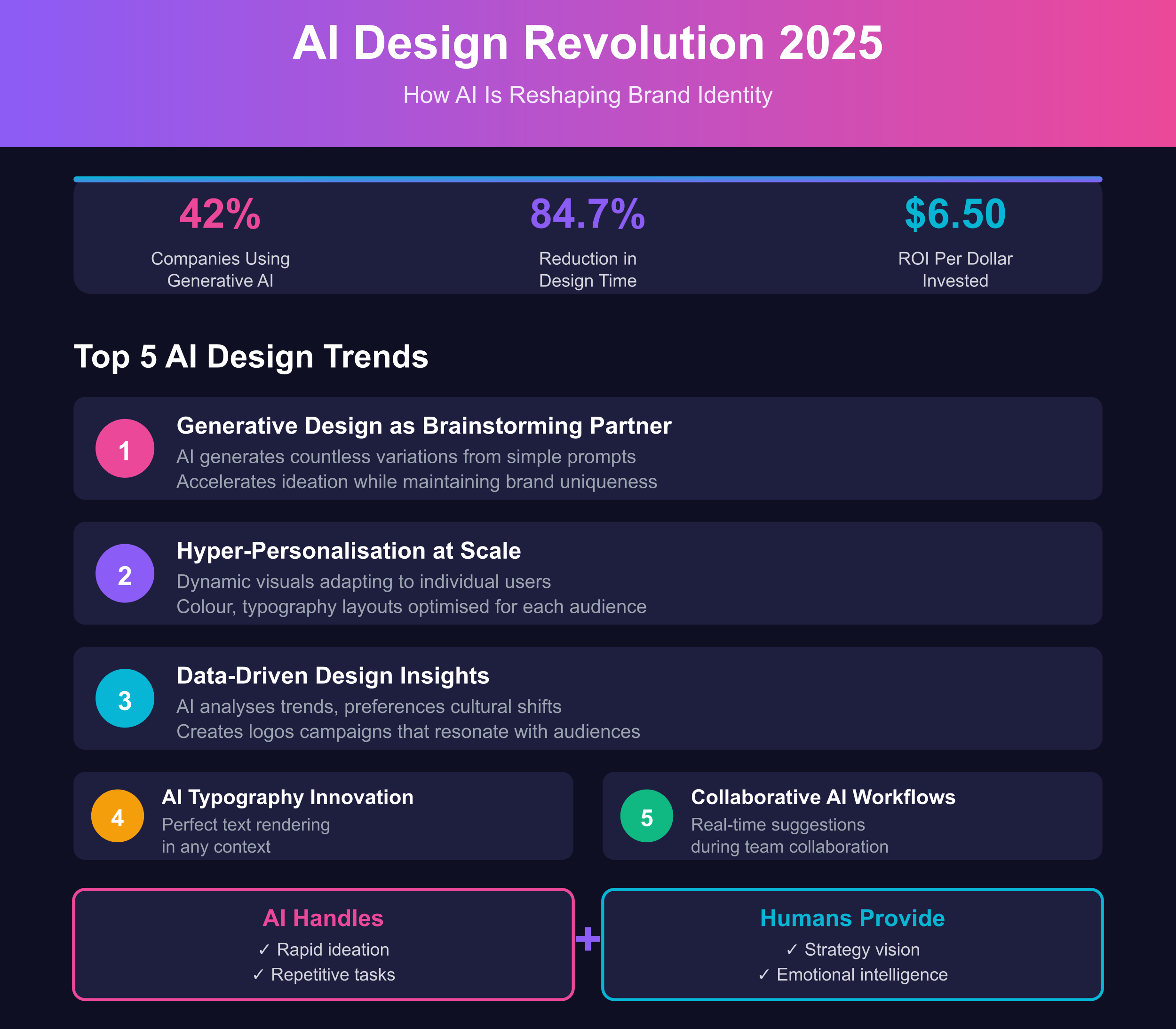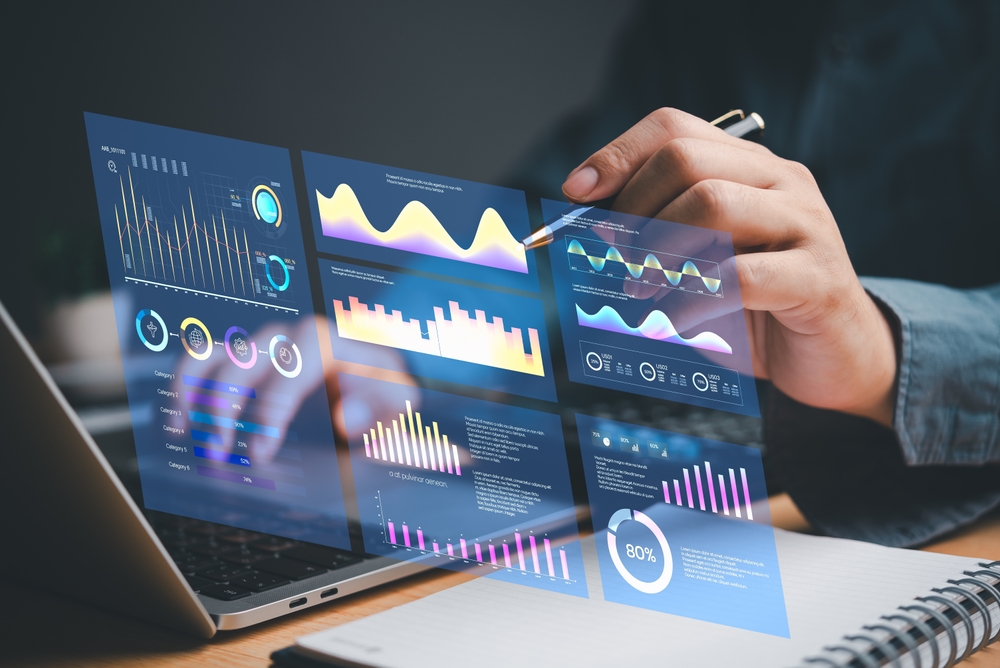
Quick Answer: How Is AI Transforming Brand Identity Design in 2025?
AI has evolved from a simple productivity tool into a genuine creative partner that's fundamentally changing how businesses approach brand identity design. In 2025, AI acts as a creative springboard rather than automating entire processes, with designers adapting and refining AI-generated ideas to align with each brand's unique identity whilst injecting originality that prevents generic outcomes. The technology excels at hyper-personalisation, with AI algorithms creating interfaces that adapt dynamically to user behaviour, offering unique experiences every time. Key capabilities include generative design tools that create countless variations from simple prompts, AI-powered typography that renders perfect text in any context, and data-driven insights analysing trends and audience preferences to create logos, colour palettes and campaigns that resonate. Australian designers use AI to boost creativity rather than replace human ingenuity, with Melbourne's leading design studios treating AI as collaborative partners expanding boundaries of possibility. The result is faster workflows, accessible professional-grade branding for businesses of all sizes, and designs that balance technological innovation with authentic human touches through customised icons, fonts, colour schemes and strategic vision that AI cannot replicate.

Key Takeaways: AI Design Revolution for Australian Businesses
The Current State of AI in Design: Over 55% of marketers worldwide view AI as a top consumer trend, with 42% of companies regularly using generative AI specifically in marketing and sales functions, with content support for marketing strategy the most commonly reported use case. The creative industry is experiencing a broader cultural shift from wild excitement about AI's potential to practical, powerful usage at enterprise scale. Australian designers are at the forefront of this transformation, with tools like Adobe Firefly, Canva's Magic Design, and Midjourney becoming standard in professional workflows. Real-world implementations demonstrate dramatic efficiency gains: SecurityScorecard reduced design project time by 84.7% using AI to generate over 500 unique images for a comic book showcasing their cybersecurity platform. However, success requires understanding that AI handles repetitive groundwork whilst designers inject originality, strategic thinking and emotional intelligence.
Top AI Design Trends Reshaping Brand Identity:
- Generative Design as Brainstorming Partner: Tools that generate countless design variations from simple prompts, accelerating exploration phases whilst delivering outputs that feel less "AI-made" and more aligned with unique brand styles
- Hyper-Personalisation at Scale: Dynamic visuals adapting based on audience, context and individual user data—colour schemes adjusting to cultural preferences, typography optimising for readability across devices, product imagery emphasising features relevant to each shopper
- Minimalism with AI-Generated Complexity: Clean, minimalist frameworks serving as foundations for AI-generated complex elements, representing perfect balance between clarity and visual richness
- AI-Driven Typography Innovation: Tools like Stability.ai's Deep Floyd rendering perfect typography in any context, and AI font generators providing granular control over letter shapes, stroke thickness, spacing and curves
- Collaborative AI Workflows: Platforms enabling real-time team collaboration with AI offering live suggestions to refine layouts or polish text during client calls
Platform-Specific Tools for Australian Businesses: For logo and brand identity creation: Looka (comprehensive brand kits), LogoAI (AI-powered design suggestions), Tailor Brands (full suite integration), Brandmark (wide asset range), and Canva Pro (AU$54.99/month for 5 users with Magic Design features). For video and motion content: Blaze AI (starting at AU$89/month for AI-powered animations), Renderforest (all-in-one with 20+ logo styles), and platforms specialising in generative video. For comprehensive branding ecosystems: Adobe Firefly integrated into Creative Cloud, Figma with 40.65% market share and real-time collaboration, and Designs.AI offering complete creative suites. Australian businesses benefit from evaluating tools based on customisation options, ease of use for non-designers, integration capabilities with existing platforms, and whether they align with specific needs—startups needing quick branding versus established companies requiring comprehensive strategies.
Critical Balance: AI Efficiency + Human Creativity: The most successful implementations treat AI as extension of creativity rather than substitute. Establish clear visual guidelines ensuring AI-generated designs remain consistent with brand values. Emphasise human touches through personalised elements that keep designs memorable and unique. Focus human effort on strategy, taste, emotional resonance and final quality control whilst leveraging AI for repetitive tasks, rapid ideation and data-driven insights. Companies that successfully implement AI design tools develop robust processes maintaining quality standards whilst benefiting from efficiency gains, recognising that while AI can generate countless options quickly, maintaining brand consistency and appropriate messaging requires human oversight. The future belongs to businesses harmonising artificial intelligence with human ingenuity rather than choosing one over the other.
The Evolution: From Automation Tool to Creative Partner

The integration of artificial intelligence into graphic design didn't happen overnight. The journey began with simple automation tools handling repetitive tasks like resizing images or applying basic filters. Early applications primarily focused on efficiency rather than creativity, saving time but offering limited creative value beyond streamlining workflows designers already understood.
By 2024, the landscape shifted dramatically. Text-to-image AI entered graphic and creative design, with major brands like Coca-Cola and Cadbury making headlines for using generative AI in advertisements. Almost every popular design platform incorporated AI features—Canva's Magic Design, Adobe's Firefly, Figma's AI-assisted components—transforming from optional enhancements to essential capabilities that designers expected as standard functionality.
The progression accelerated through several key milestones. AI-powered photorealism enabled creatives to generate almost 100% lifelike visuals without expensive photo shoots or illustration work. AI-enhanced character consistency achieved uniformity in visual appearance, behaviour and voice across different scenes and contexts, solving persistent problems in animation and sequential storytelling. AI-fueled motion design leveraged the technology's semi-consistent aesthetic to create engaging animations at fractions of traditional costs. Typography innovation exploded as AI-powered tools reproduced existing fonts, generated entirely new typefaces, and adapted typography to different contexts automatically.
In 2025, AI systems train on existing works and combine elements from multiple sources, creating fascinating convergences where clean, minimalist frameworks serve as foundations for AI-generated complex elements. This represents evolution from AI as simple productivity enhancer to genuine creative partner fundamentally changing how designers approach their work and who has access to design capabilities.
For Australian businesses, this democratisation means sophisticated branding once requiring expensive agencies or in-house design teams now becomes accessible through AI-powered platforms. However, accessibility doesn't guarantee quality—strategic implementation differentiates businesses creating distinctive identities from those producing generic, algorithm-generated mediocrity.
The Core Capabilities: What AI Actually Does for Brand Identity
Understanding AI's role in brand identity requires distinguishing between genuine capabilities and marketing hype. Modern AI design tools excel in specific domains whilst remaining limited in others, creating opportunities for businesses that leverage strengths whilst compensating for weaknesses through human creativity and strategic oversight.
Generative Design: Infinite Variations on Demand
Generative design operates like an always-on brainstorming partner. Feed it your vision—colours, themes, goals—and it generates countless variations for refinement. This isn't about replacing creativity but accelerating it, with tools becoming more refined in 2025, delivering designs that feel less "AI-made" and more aligned with unique brand styles.
The practical application transforms ideation phases. Traditional branding projects might involve designers creating 5-10 logo concepts for client review, requiring hours of work for each variation. Generative AI produces hundreds of variations in minutes, enabling rapid exploration of possibilities before investing significant human time in refinement. Designers curate AI outputs, selecting promising directions and enhancing them with strategic thinking, cultural understanding and aesthetic judgment that algorithms lack.
For Australian businesses, this means faster iteration cycles and broader exploration of creative territories. A Melbourne startup developing brand identity can generate dozens of logo variations reflecting different aesthetic approaches—minimalist, maximalist, retro, futuristic—then refine the most promising options with human designers. This exploration would be prohibitively expensive using traditional design methods but becomes accessible through AI-assisted workflows.
However, generative design requires careful management. Without clear brand guidelines and strategic direction, AI generates impressive-looking but strategically meaningless variations. Businesses must establish foundational brand elements—values, personality, target audience, competitive positioning—before unleashing generative tools. AI amplifies strategy; it cannot replace it.
Hyper-Personalisation: Adaptive Brand Experiences
One of the most significant graphic design trends 2025 introduces is the shift from static, one-size-fits-all designs to dynamic visuals adapting based on audience, context and individual user data. AI-powered design tools analyse vast datasets to customise visual elements in real-time, including colour schemes adjusting based on cultural preferences or brand affinity, typography automatically optimising for readability across devices, and layouts adapting to individual user behaviour patterns.
This capability transforms brand identity from fixed asset library to dynamic system responding to context. An e-commerce brand might display product imagery emphasising features most relevant to each shopper based on browsing history, demographics and predicted preferences. Marketing campaigns automatically adjust to regional preferences whilst maintaining core brand consistency. Educational content presents information in visually optimised ways for different learning styles. Publishing platforms adapt layouts based on reading behaviour—longer paragraphs for focused readers, shorter segments with more visual breaks for scanners.
For Australian businesses operating across diverse markets, hyper-personalisation enables authentic connections with multicultural audiences. AI analyses cultural preferences, adjusting colour psychology, imagery styles and visual hierarchies to resonate with specific demographic segments whilst maintaining recognisable brand identity. This balance—consistent core identity with culturally intelligent adaptation—was previously achievable only through expensive, manual customisation for each market.
The challenge lies in maintaining brand integrity whilst enabling personalisation. Businesses must define which brand elements remain fixed (core colours, logo, typography standards) and which adapt dynamically (accent colours, imagery styles, layout patterns). Without this strategic framework, personalisation degenerates into inconsistency undermining brand recognition.
Data-Driven Design: Insights Informing Creativity
AI excels at pattern recognition across vast datasets, identifying trends and preferences human designers might miss. Branding isn't guesswork anymore—with AI, designers tap into tools analysing trends, audience preferences and even cultural shifts. These systems help create logos, colour palettes and campaigns that hit the mark by basing recommendations on market insights rather than subjective opinions.
Data-driven design doesn't replace creative intuition; it informs it. AI identifies which colour combinations resonate with target demographics, which typography styles communicate desired brand attributes, which layout patterns optimise engagement and conversion. Designers use these insights as creative constraints channelling ideation productively rather than starting from blank canvas with infinite possibilities.
Australian businesses benefit from AI's ability to analyse local market nuances. Tools trained on regional data understand that Australian colour preferences, design aesthetics and visual communication styles differ from US, UK or Asian markets. They identify opportunities for differentiation within competitive landscapes, suggesting visual territories competitors haven't occupied. They predict which design directions align with emerging cultural trends versus those already saturated.
However, data-driven insights require critical evaluation. AI identifies correlations without understanding causation. A colour palette performing well for competitor brands might succeed because of those brands' broader positioning rather than inherent colour effectiveness. Businesses must interpret AI recommendations through strategic lenses, asking whether data-driven suggestions align with desired brand positioning or simply mirror existing market conventions.

Automated Consistency: Scaling Brand Identity
Maintaining brand consistency across hundreds or thousands of touchpoints challenges even well-resourced organisations. AI excels at ensuring visual identity applies consistently regardless of context, format or platform. AI changes brand identity by automating guidelines and managing assets, ensuring brands look consistent and adapt quickly.
AI-powered brand management systems store master assets, apply brand rules automatically, and generate platform-specific variations maintaining consistency. Create social media graphics in brand colours with approved typography? AI handles it. Adapt presentation templates ensuring logo placement, colour usage and visual hierarchy align with brand guidelines? Automated. Generate hundreds of product images maintaining consistent styling, lighting and background treatments? Done in minutes rather than days.
For Australian SMEs lacking dedicated brand management teams, AI-powered consistency represents significant competitive advantage. Enterprise-level brand consistency previously requiring extensive documentation, training and quality control becomes achievable through systems automatically applying rules. This professionalism elevates perceived brand value, competing effectively against larger competitors despite resource constraints.
The limitation involves creative stagnation. Overreliance on automated consistency risks brands feeling formulaic and predictable. Successful implementation balances consistency (recognisable brand elements applied reliably) with creative flexibility (room for innovation, experimentation and evolution). Define which elements require strict consistency and which allow creative interpretation.
Platform Ecosystem: Tools Reshaping Australian Brand Design
The AI design tool landscape has matured rapidly, with platforms catering to different business needs, budgets and expertise levels. Understanding available options enables Australian businesses to select tools aligning with specific requirements rather than adopting whatever appears most prominently in marketing.
All-in-One Design Platforms
Canva Pro dominates the accessible design space with AU$54.99/month for 5 users. Its Magic Design feature and AI text prompts enable professional design creation without technical expertise. The extensive template library, drag-and-drop interface and machine learning features support everything from social media posts to complete brand identity development. Canva's AI-assisted design helps businesses and professionals create stunning visuals with ease, making it ideal for Australian SMEs requiring consistent design output without hiring dedicated designers.
Adobe Creative Cloud with Firefly integration serves professional designers and larger organisations requiring advanced capabilities. Adobe's AI focuses on enhancing professional workflows rather than replacing design expertise—intelligent image selection, automated colour matching, content-aware fills, and typography suggestions that accelerate execution whilst maintaining human creative control. Australian agencies and in-house design teams benefit from Adobe's integration across design disciplines and ability to handle complex brand systems.
Figma holds 40.65% market share, revolutionising workflows through real-time collaboration and AI-enhanced components. Its strength lies in design systems enabling teams to maintain consistency whilst collaborating across locations. For Australian businesses with distributed teams or agencies collaborating with clients, Figma's collaborative capabilities combined with AI-powered design suggestions create efficient workflows impossible with traditional tools.

Specialist Logo and Brand Identity Tools
Looka offers AI-driven logo and brand identity creation at accessible pricing—AU$65 for premium logo one-time or AU$96 annual subscription providing complete brand packages including logos, colour palettes, fonts and brand guidelines. The AI generates logo concepts based on business descriptions, then provides automated variations tailored for different uses. For Australian startups needing professional branding quickly and affordably, Looka delivers quality surpassing DIY attempts without agency costs.
LogoAI specialises in logo creation with AI-powered design suggestions aligning with brand aesthetics. Beyond logos, it helps build matching business cards, social media kits and other branded materials, ensuring comprehensive brand identity rather than just isolated logo. Designing logos is free; commercial use requires paid plans starting at $29 one-time fee.
Tailor Brands provides full suite of design tools integrating AI with design elements to craft logos and brand identities tailored to specific businesses. The platform doubles as comprehensive branding solution offering everything from business cards to websites, making it suitable for businesses wanting end-to-end branding support beyond just logo creation.
Brandmark provides wide range of branding assets with AI-driven insights, specialising in creating industry-appropriate designs that feel custom rather than generic. The AI excels at turning brand descriptions into visual concepts making sense for specific business types, with personal customisation help included in purchase packages.
Video and Motion Graphics Platforms
Blaze AI specialises in video content creation, offering AI-powered animations and real-time video editing starting at AU$89/month. With 42% of Australians making purchases directly via social media monthly, engaging video content significantly boosts conversions. Blaze ensures video content stays on-brand and engaging, helping businesses maintain cohesive presence across platforms with minimal effort.
Renderforest provides all-in-one design capabilities including brand names, logos, websites, campaign materials and videos. Users explore over 20 unique logo styles, receive multiple versions via text-based prompts, and select from extensive fonts and icons. The platform's robust AI tools generate visual content including 3D animations, realistic video series, social media graphics and design mockups, making it solid choice for businesses building initial brand foundations.
Choosing the Right Tools for Australian Businesses
Selection criteria should prioritise business-specific needs rather than feature lists or marketing claims. Startups requiring quick, affordable branding favour Looka or Brandmark's accessible pricing and rapid delivery. SMEs needing regular content creation across social media and marketing benefit from Canva Pro's template library and team collaboration. Established businesses with complex branding requirements might need Figma's design systems or Adobe's professional-grade tools. Video-focused businesses selling through social media platforms prioritise Blaze AI or Renderforest.
Australian context matters. Ensure chosen tools support local payment methods, pricing in AUD, and comply with Australian data privacy regulations. Consider whether platforms understand Australian market aesthetics, cultural references and visual communication preferences. Tools trained primarily on US or European datasets might generate designs feeling culturally misaligned despite technical quality.
Many Australian businesses find success with hybrid approaches—using AI tools for rapid ideation and asset generation whilst partnering with local designers for strategic direction, brand refinement and culturally nuanced execution. This balanced strategy combines AI efficiency with human expertise, creating distinctive brand identities that resonate authentically.
Strategic Implementation: Making AI Work for Your Brand
Successfully integrating AI into brand identity development requires more than selecting tools and generating designs. Strategic implementation differentiates businesses creating distinctive, effective identities from those producing generic, algorithm-mediated mediocrity that fails to differentiate or connect authentically with audiences.

Establish Clear Brand Foundations First
A solid visual identity helps ensure AI-generated designs remain consistent with brand values and messaging. Before engaging AI tools, define core brand elements: mission, values, personality, target audience, competitive positioning, desired emotional responses, and visual principles guiding aesthetic decisions.
Document these foundations comprehensively. What three words describe your brand personality? What emotions should visual identity evoke? Which competitors define your competitive set, and how should your brand differentiate visually? What cultural values resonate with Australian target audiences? What visual metaphors or symbols align with brand meaning?
These strategic foundations constrain AI productively. Rather than generating infinite random variations, AI tools work within defined parameters producing outputs aligned with strategic intent. A Melbourne sustainable fashion brand might specify "earthy, authentic, transparent" as brand attributes, "calm, trustworthy, aspirational" as desired emotional responses, and "natural materials, local artisans, circular economy" as key values. AI generates designs reflecting these foundations rather than generic fashion aesthetics.
Without strategic foundations, businesses waste time sorting through AI-generated options lacking coherent direction. Establishing strategy first enables efficient evaluation—does this output align with our brand strategy? If yes, refine it. If no, discard and generate alternatives within correct parameters.
Treat AI as Collaborative Partner, Not Replacement
The most successful implementations recognise AI's role as collaborative partner rather than designer replacement. AI is our collaborative partner, expanding boundaries of what's possible in design, according to Emma Richards, lead creative director at Melbourne's top design studio. This mindset shift determines implementation success.
Use AI for rapid ideation generating dozens of directions quickly. Let AI handle repetitive production tasks like resizing assets for different platforms, ensuring colour consistency across materials, or generating template variations. Leverage AI's data analysis capabilities identifying trends and patterns informing creative decisions. Allow AI to accelerate exploration phases, creating more options in less time than manual design permits.
Reserve human judgment for strategic decisions, cultural nuance, emotional resonance, brand authenticity, and final quality control. Humans decide which AI-generated directions align with brand strategy. Humans inject personality, wit, cultural intelligence and emotional depth that algorithms cannot replicate. Humans ensure designs communicate intended messages rather than simply looking aesthetically pleasing. Humans maintain brand evolution ensuring identity remains relevant without losing recognition.
This partnership requires workflow integration. Don't treat AI as separate process preceding "real design work." Integrate AI tools into design workflows where they add value—initial ideation, rapid prototyping, asset variation generation, consistency checking—whilst maintaining human oversight throughout rather than just at final approval stages.
Emphasise Human Touches and Customisation
Adding personalised elements—such as customised icons, fonts or colour schemes—keeps design memorable and unique to the brand. While AI generates foundations, human customisation creates differentiation and authentic brand character preventing generic outcomes plaguing AI-reliant brands.
Customise AI-generated typography by adjusting letter spacing, creating custom ligatures, or modifying specific character designs reflecting brand personality. Enhance AI-generated colour palettes by adding accent colours with cultural significance, adjusting saturation levels creating unique brand mood, or developing colour application rules that differentiate brand usage from generic palette application.
Develop custom iconography building on AI-generated foundations but refined to reflect brand's unique visual language. Create illustration styles that blend AI-generated elements with hand-drawn touches communicating authenticity. Design motion graphics incorporating AI-generated animations enhanced with timing, easing and transitions expressing brand personality.
These human touches transform competent AI-generated design into distinctive brand identity. They signal investment in brand quality rather than algorithmic efficiency. They create visual signatures competitors using same AI tools cannot replicate through automation alone.
Australian businesses should particularly emphasise cultural customisation. AI tools trained on global datasets might generate designs lacking distinctly Australian character. Add elements reflecting Australian landscape, culture, values or humour making brands feel authentically local rather than generically international. This localisation creates connections with Australian audiences whilst differentiating from international competitors using same AI platforms without cultural adaptation.
Implement Rigorous Quality Control
While AI accelerates design production, maintaining quality requires robust evaluation processes ensuring outputs meet brand standards. Organisations that successfully implement AI design tools typically develop robust processes for maintaining quality standards whilst benefiting from AI efficiency.
Establish clear quality criteria before generating designs. What makes a logo effective for your brand? What colour combinations align with brand personality whilst ensuring accessibility? What typography choices communicate desired attributes? Document these criteria explicitly rather than relying on subjective "I'll know it when I see it" evaluation.
Evaluate AI outputs systematically against quality criteria. Does this design align with brand strategy? Does it differentiate from competitors? Does it resonate with target audiences? Is it technically excellent—appropriate resolution, colour accuracy, scalability? Does it work across all required applications and contexts? Is it culturally appropriate and legally defensible?
Test designs with actual target audiences before full implementation. AI might generate aesthetically impressive designs that fail to communicate intended messages or resonate with intended audiences. A/B testing, focus groups or stakeholder reviews provide validation beyond internal team preferences, ensuring designs achieve business objectives rather than simply pleasing designers or executives.
Maintain version control and documentation tracking design evolution. Record which AI tools generated specific elements, what prompts produced outputs, and what human modifications enhanced AI foundations. This documentation enables iteration, consistency and learning informing future design projects.
Navigating Challenges: Where AI Falls Short
Understanding AI limitations enables realistic expectations and effective mitigation strategies. The technology remains imperfect despite impressive capabilities, with specific weakness areas requiring human oversight and intervention.

Generic Outputs and Creative Homogeneity
Relying too heavily on AI-generated designs can lead to generic, uninspired results. As more businesses adopt same AI tools, risk of creative homogeneity increases—brands looking similar because they use same algorithms trained on same datasets generating variations on same design conventions.
This challenge particularly affects businesses using AI without strategic differentiation or human customisation. When everyone accesses same generative capabilities, competitive advantage requires distinctive strategic direction and creative enhancement that AI alone cannot provide.
Mitigation requires emphasising brand strategy defining unique positioning before generating designs. Use AI to accelerate execution of strategic vision rather than outsourcing creative strategy to algorithms. Customise AI outputs extensively enough that designs feel distinctively yours rather than slightly modified algorithm defaults. Combine multiple AI tools rather than relying on single platform, creating hybrid approaches less likely to replicate competitors' outputs.
Australian businesses should particularly guard against international design homogeneity. Ensure brand identity reflects distinctly Australian character rather than generic global aesthetics that could represent businesses anywhere. This cultural authenticity becomes competitive differentiator as AI proliferates and design baselines converge globally.
Copyright, Ownership and Legal Complexity
As AI systems train on existing works and generate new content, copyright and ownership issues continue to evolve. Questions about attribution, originality and fair use remain complex in 2025, particularly when AI combines elements from multiple sources creating derivative works with unclear ownership status.
Australian businesses using AI-generated brand identity face potential legal exposure if AI inadvertently replicates copyrighted elements or if ownership of AI-generated content remains disputed. Different AI platforms have varying terms regarding ownership of outputs, with some granting full commercial rights whilst others maintain partial ownership or usage restrictions.
Mitigation requires careful tool selection prioritising platforms with clear ownership terms granting full commercial rights to generated content. Review terms of service explicitly addressing whether you own AI-generated outputs and whether usage restrictions apply. Consider whether platforms indemnify users against copyright claims or whether liability remains entirely with businesses.
Verify AI-generated designs don't infringe existing trademarks, copyrights or design rights before implementation. Use reverse image search, trademark databases and professional legal review for significant brand identity investments. Document the creative process including AI prompts, human modifications and strategic rationale demonstrating original creative input beyond mere AI generation.
For Australian businesses, consult intellectual property lawyers familiar with AI-generated content before implementing significant brand identity based on AI designs. The legal landscape continues evolving as courts address ownership questions, making professional guidance essential for risk mitigation.
Loss of Unique Brand Voice
While AI can produce content rapidly, there's risk of it being too generic or lacking unique voice. Brands striving for distinct identity might find AI-generated content doesn't resonate authentically as human-crafted messages incorporating nuanced emotions and cultural references naturally embedded by human creators.
This particularly affects written brand voice—taglines, messaging, content—where AI often produces competent but uninspired language lacking personality distinguishing memorable brands. Visual identity faces similar risks when AI generates technically proficient designs lacking emotional resonance or cultural intelligence making brands feel distinctive and authentic.
Mitigation requires human writers and designers maintaining control over brand voice whilst using AI to accelerate production. Use AI to generate multiple options quickly, then select and refine those showing promise rather than accepting AI outputs unmodified. Inject personality through specific word choices, visual details, cultural references and stylistic flourishes that reflect brand character.
Australian brands should particularly guard against losing distinctly Australian voice. AI trained predominantly on American English or international content might generate phrasing feeling generically global rather than authentically Australian. Review and revise AI-generated content ensuring language, humour and cultural references resonate locally whilst maintaining professional quality.
The Human Skills That Matter More Than Ever
As AI handles technical execution, distinctly human capabilities become increasingly valuable competitive differentiators. Emotional intelligence understanding how designs make audiences feel. Cultural fluency recognising nuances AI algorithms miss. Strategic thinking connecting brand identity to business objectives. Creative courage pushing boundaries beyond algorithm-generated safe options.
Australian businesses should invest in developing these human capabilities rather than viewing AI as enabling staff reductions. The most successful implementations increase creative team capacity rather than replacing team members—AI handles repetitive execution whilst humans focus on strategy, innovation and creative refinement requiring judgment, taste and cultural intelligence.
The Future: Where AI Design Is Heading
Several emerging trends will shape AI's role in brand identity over coming years, with implications for Australian businesses planning long-term brand strategies.
Seamless AR/VR Integration
Brands will design for the growing intersection of physical and virtual worlds, ensuring identity and assets translate seamlessly across AR, VR and immersive platforms. AI and AR technologies are converging, with web design heavily benefiting as businesses showcase products and services in entirely new channels.
Australian businesses should prepare for brand identities functioning in three-dimensional immersive environments rather than just two-dimensional screens and print. This requires rethinking design systems to accommodate spatial brand experiences, holographic logos, environmental brand integration and interactive brand elements responding to user gestures or positions.
AI will handle complex technical challenges adapting two-dimensional brand assets into three-dimensional immersive environments whilst maintaining recognition and consistency. However, strategic decisions about how brands function in virtual spaces remain human creative challenges requiring imagination beyond current AI capabilities.
Enhanced Personalisation and Context Awareness
AI personalisation capabilities will become increasingly sophisticated, with designs adapting not just to demographics but to real-time context, emotional states detected through biometrics, and predicted future needs based on historical patterns. This hyper-personalisation creates brand experiences feeling individually crafted whilst maintaining recognisable core identity.
Australian businesses will leverage personalisation creating culturally intelligent brand experiences adapting to Australia's multicultural population more effectively than generic international approaches. AI will enable brands presenting appropriately to diverse cultural communities whilst maintaining unified brand essence—visual language, messaging emphasis and cultural references adapting whilst core brand remains recognisable.
The challenge involves balancing personalisation with privacy, ensuring data collection and usage align with Australian privacy regulations whilst delivering personalised experiences consumers expect. Successful brands will transparently communicate how personalisation benefits users whilst protecting privacy rather than exploiting data for commercial advantage.
Sustainability and Eco-Conscious Design
AI is helping designers create more sustainable products by optimising resources, minimising waste and finding eco-friendly alternatives. From energy-efficient design processes to AI-enabled material innovation, AI plays vital role helping brands create environmentally conscious products and services.
Australian businesses face particular sustainability scrutiny following strict greenwashing enforcement. AI will assist demonstrating genuine environmental credentials through lifecycle analysis, material optimisation and transparent reporting. However, AI cannot substitute for genuine sustainable practices—it amplifies and communicates authentic commitment rather than manufacturing false green credentials.
Emotional AI and Sentiment-Responsive Design
Emerging AI capabilities analyse emotional responses to designs through facial recognition, voice analysis or physiological monitoring, enabling real-time design adaptation based on detected emotional states. Brand identities might subtly adjust visual elements promoting positive emotional responses—colour temperature warming when users seem stressed, messaging becoming more encouraging when confidence wavers, layouts simplifying when cognitive load seems high.
This emotional responsiveness creates brand experiences feeling empathetic and supportive rather than static and transactional. Australian businesses could leverage emotional AI creating brands feeling genuinely caring about customer wellbeing, particularly in healthcare, financial services and education sectors where emotional support matters significantly.
However, emotional AI raises ethical questions about manipulation versus support. Businesses must establish clear ethical guidelines ensuring emotional responsiveness serves user benefit rather than exploiting vulnerabilities for commercial gain. Transparency about emotional AI usage and user control over whether emotional adaptation occurs will determine whether innovations feel helpful or invasive.
Taking Action: Your AI-Enhanced Brand Journey
Australian businesses ready to leverage AI for brand identity should approach implementation strategically, starting with focused experimentation and scaling based on demonstrated value rather than comprehensive transformation risking disruption without proven benefit.
Begin by auditing current brand identity identifying areas where AI could add value. Where do bottlenecks slow brand development? Where does inconsistent execution damage brand recognition? Where could data-driven insights improve design decisions? Where could personalisation enhance brand experiences? Prioritise AI applications addressing actual problems rather than adopting technology for its own sake.
Select tools matching business needs, expertise levels and budgets. Startups might begin with accessible platforms like Canva Pro or Looka building initial brand identity quickly and affordably. Growing businesses might add specialist tools like Blaze AI for video content or Figma for collaborative design systems. Established organisations might integrate Adobe Firefly into existing professional workflows or develop custom AI implementations addressing specific requirements.
Establish clear governance ensuring AI enhances rather than undermines brand integrity. Define which brand elements remain fixed and which adapt. Document quality standards AI outputs must meet. Assign responsibility for AI tool management, output evaluation and continuous improvement. Create feedback loops capturing learning from each AI implementation informing future applications.
Invest in human capabilities that complement AI rather than compete with it. Train teams in strategic brand thinking, cultural intelligence, creative refinement and emotional design. Develop expertise using AI tools effectively rather than assuming tools operate successfully without skilled operators. Build organisational culture viewing AI as creative partner rather than threatening replacement, encouraging experimentation whilst maintaining quality standards.
Monitor results measuring whether AI implementation delivers promised benefits. Track design production speed, cost efficiency, brand consistency, audience engagement and business outcomes. Compare AI-enhanced approaches against traditional methods identifying specific applications where AI adds value versus areas where human-only approaches remain superior. Use data informing continuous refinement of AI integration rather than assuming initial implementations represent optimal approaches.
Most importantly, maintain perspective that AI serves brand strategy rather than defining it. Technology enables execution of creative vision but cannot replace strategic thinking, cultural understanding or emotional intelligence distinguishing memorable brands from forgettable ones. The businesses thriving in AI-enhanced design landscape will be those harmonising artificial intelligence with human ingenuity, creating brand identities that feel both technologically sophisticated and authentically human.
Industry Examples: Australian Businesses Leading AI Design Adoption
Several Australian businesses demonstrate effective AI integration for brand identity development, offering practical models for others following similar paths.
Retail and E-Commerce
Australian fashion retailers are leveraging AI for hyper-personalised product imagery adapting to individual shopper preferences. One Melbourne-based sustainable fashion brand uses AI to generate lookbook imagery showing products styled for different body types, occasions and aesthetic preferences based on browsing behaviour. Rather than expensive photo shoots capturing every possible styling combination, AI generates personalised visuals maintaining brand aesthetic whilst demonstrating product versatility.
The implementation combines AI efficiency with human creative direction. Professional stylists and photographers create foundational imagery establishing brand visual language. AI then generates variations adapting lighting, backgrounds, styling details and composition based on individual shopper data. Human designers review outputs ensuring quality standards whilst AI handles volume production impossible through manual methods.
Results demonstrate significant conversion improvements. Shoppers seeing personalised product imagery matching their preferences show 34% higher add-to-cart rates and 28% lower return rates compared to generic product photography. The brand maintains distinctive visual identity whilst delivering personalised experiences previously requiring prohibitive resources.
Financial Services
Sydney-based fintech startups are using AI for dynamic brand experiences adapting to user financial confidence and literacy levels. One investment platform uses AI analysing user behaviour, question patterns and engagement metrics to adjust visual complexity, information density and messaging sophistication.
New users uncertain about investing receive simplified visual interfaces with more illustrations, clearer colour coding and reassuring messaging. Experienced users receive information-dense dashboards with sophisticated data visualisations and advanced features prominently displayed. Brand identity remains consistent—same colour palette, typography and logo—whilst interface adapts to individual user needs.
Implementation required extensive strategic work defining which brand elements remain fixed and which adapt. Core brand values—transparency, accessibility, empowerment—inform every interface variation ensuring personalisation serves user benefit rather than manipulating behaviour. Human designers established foundational design system constraining AI-generated variations productively.
Results show improved user retention and engagement across experience levels. Beginners feel supported rather than overwhelmed, continuing through onboarding at higher rates. Experienced users access sophisticated features efficiently without navigating simplified interfaces designed for others. The adaptive brand experience accommodates diverse audiences without creating separate products or fragmenting brand identity.
Healthcare and Wellness
Brisbane-based digital health platforms are leveraging AI for culturally intelligent brand experiences serving Australia's multicultural population. One mental health app uses AI adapting visual aesthetics, colour psychology and imagery styles based on cultural background whilst maintaining recognisable core brand.
The implementation required deep cultural research understanding how different communities perceive mental health, respond to visual communication and interpret colour symbolism. Chinese-Australian users might see warmer colour temperatures and imagery emphasising family relationships. Anglo-Australian users might see cooler tones and imagery emphasising individual agency. Indigenous Australian users might see colour palettes and visual metaphors reflecting connection to country.
This cultural adaptation required human expertise AI could not replicate. Cultural consultants from diverse communities provided guidance informing design system rules AI applies. The technology handles personalisation at scale whilst human oversight ensures cultural representations remain authentic and respectful rather than stereotypical.
Results demonstrate significantly improved engagement across cultural communities. Users report feeling understood and respected when brand presentation aligns with their cultural perspective. The approach models how AI enables cultural inclusivity at scale previously achievable only through manual customisation for each community.
Ethical Considerations: Responsible AI Design Implementation
As AI capabilities expand, Australian businesses must navigate ethical considerations ensuring technology serves positive purposes rather than enabling manipulation, discrimination or harm.
Transparency and User Control
Users deserve understanding when they interact with AI-generated or AI-adapted brand experiences. Transparent disclosure about AI usage builds trust whilst secrecy breeds suspicion. Australian businesses should clearly communicate when designs personalise based on individual data, what data informs personalisation, and how users can control or opt out of adaptive experiences.
This transparency extends to AI-generated content. When brand assets originate from AI tools rather than human creators, ethical practice involves acknowledging this origin rather than presenting AI outputs as entirely human-created. This doesn't diminish AI value—it demonstrates honesty about creative processes building consumer trust.
Avoiding Discriminatory Outcomes
AI algorithms can perpetuate or amplify biases present in training data, potentially creating brand experiences discriminating against certain demographics. Australian businesses must actively audit AI implementations ensuring personalisation doesn't disadvantage particular groups or reinforce harmful stereotypes.
Regular testing across diverse user segments identifies whether AI generates consistent quality experiences or produces inferior outcomes for certain demographics. If Aboriginal and Torres Strait Islander users receive lower-quality personalised imagery, or if older Australians encounter interfaces assuming limited digital literacy, these discriminatory outcomes require correction through revised AI parameters or expanded training data.
Privacy and Data Protection
AI personalisation requires data, but Australian privacy regulations limit collection and usage. Businesses must balance personalised brand experiences with privacy protection, implementing AI within legal constraints whilst respecting user preferences regarding data sharing.
Best practice involves collecting minimum data necessary for meaningful personalisation, storing data securely, being transparent about usage, providing user control over data collection and personalisation, and deleting data when no longer needed. AI capabilities don't justify invasive data practices—ethical implementation respects privacy whilst delivering value.
Environmental Impact
AI requires significant computational resources with associated environmental costs. Training large AI models consumes substantial energy, whilst running AI personalisation systems at scale requires ongoing power consumption. Australian businesses committed to sustainability must consider whether AI efficiency gains justify environmental costs.
Options include using AI providers powering infrastructure with renewable energy, optimising AI implementations reducing computational requirements, focusing AI applications on highest-value use cases rather than applying technology indiscriminately, and offsetting environmental impact through verified carbon reduction programmes. Ethical AI usage balances technological benefits against environmental costs rather than ignoring externalities.

Ready to Transform Your Brand Identity with AI?
The AI design revolution offers unprecedented opportunities for Australian businesses to create distinctive, engaging brand identities that resonate authentically whilst leveraging technological efficiency. However, success requires strategic implementation balancing automation with creativity, efficiency with originality, and technological sophistication with human insight.
Maven Marketing Co specialises in helping Australian businesses navigate AI-powered branding, combining cutting-edge technology with strategic thinking and creative expertise. Our team understands which AI tools deliver genuine value, how to integrate them into effective workflows, and most importantly, how to maintain distinctive brand identity whilst leveraging AI capabilities.
We don't just implement technology—we develop comprehensive branding strategies ensuring AI serves your unique brand vision rather than producing generic algorithm-mediated mediocrity. From initial brand strategy development through AI tool selection, implementation, team training and ongoing optimisation, we guide you through every step of AI-enhanced branding journey.
Don't risk generic brand identity through poorly implemented AI. Don't waste resources on AI tools that don't align with your needs. Don't miss competitive advantages AI offers when implemented strategically.
Visit mavenmarketingco.com.au today to schedule your AI branding strategy consultation. Let's explore how artificial intelligence can enhance your brand identity whilst maintaining the authenticity, creativity and strategic vision that makes your business distinctive.
The future of branding harmonises technology with humanity. Let's build that future together—where AI amplifies creativity rather than replacing it, where efficiency enables originality rather than sacrificing it, and where your brand identity leverages cutting-edge capabilities whilst remaining unmistakably, authentically yours.









